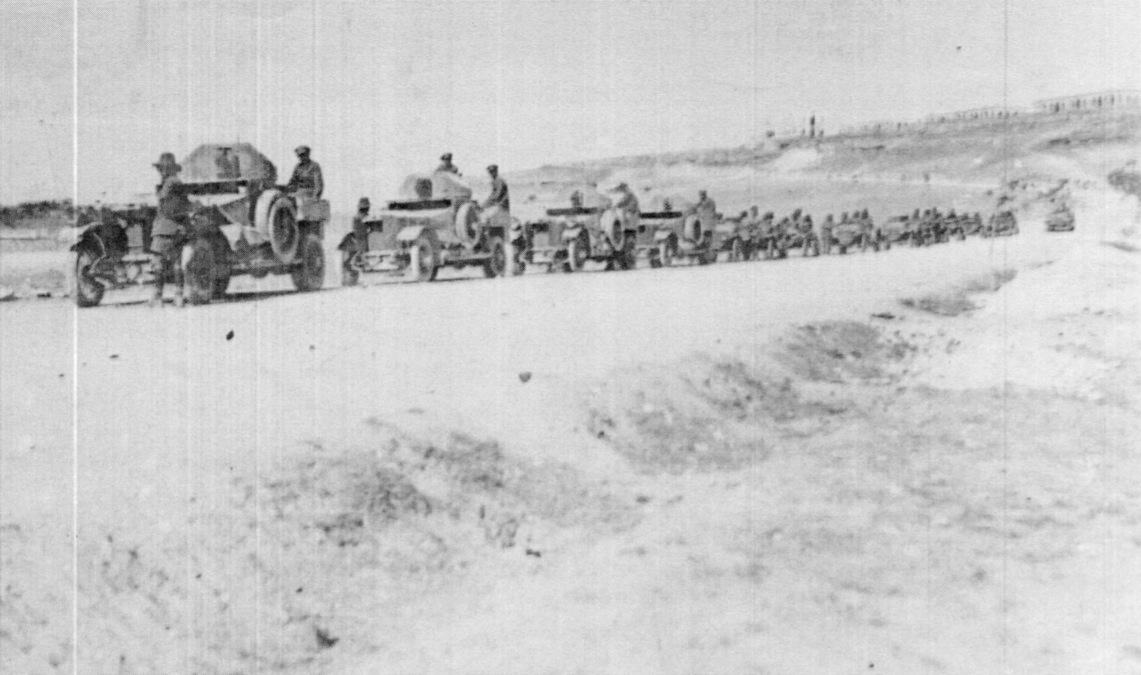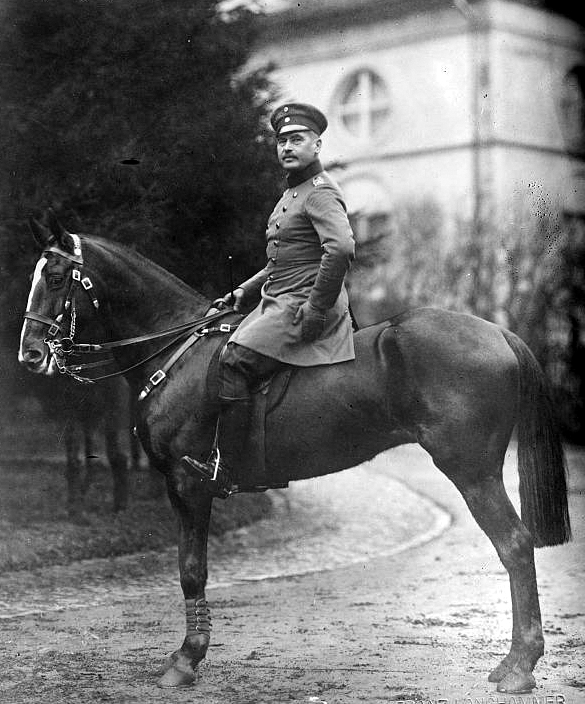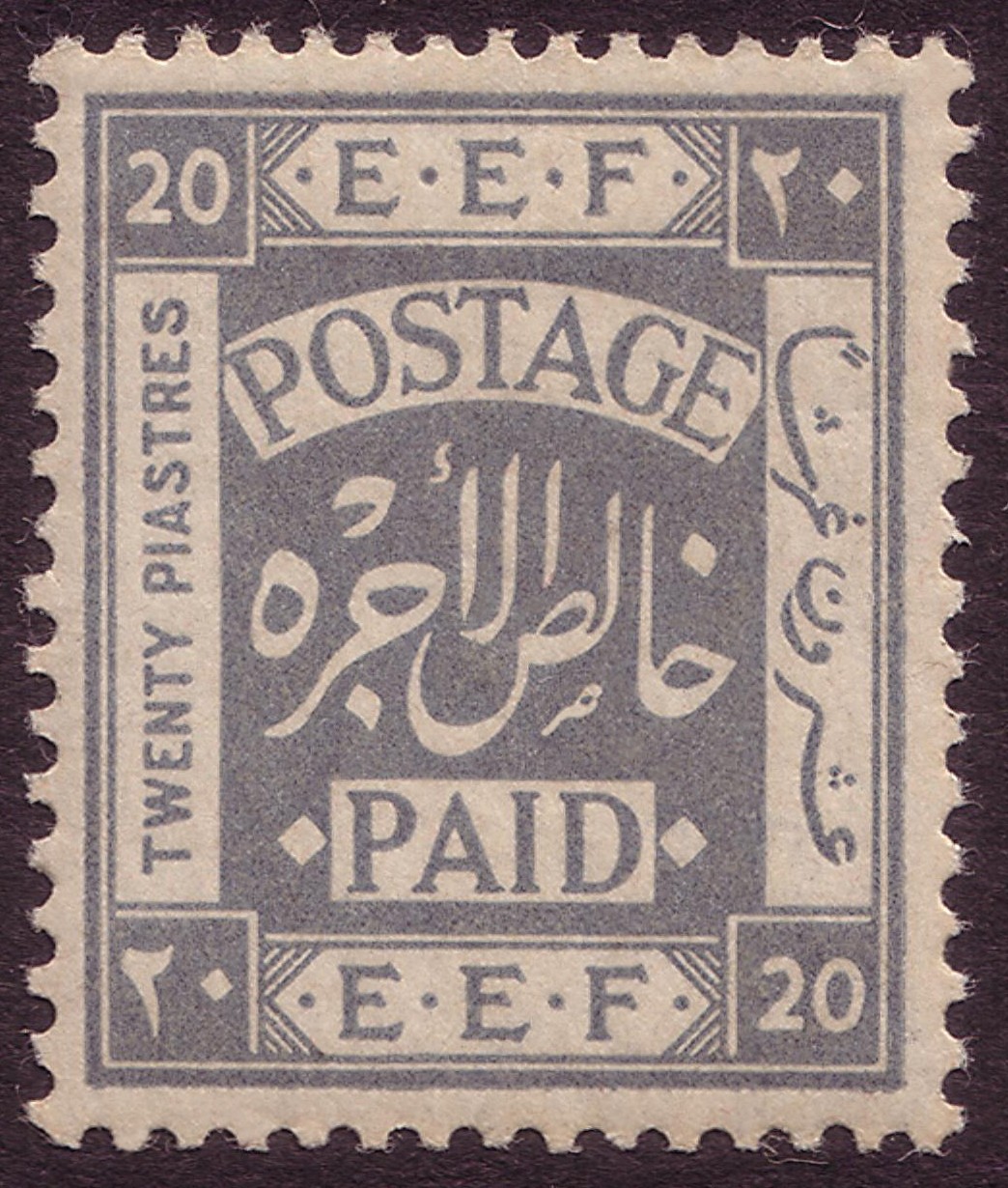|
Charge At Haritan
The Charge at Haritan occurred on 26 October 1918 at the end of the Pursuit to Haritan during the final stages of the Sinai and Palestine Campaign of the First World War. Two regiments of the 15th (Imperial Service) Cavalry Brigade, 5th Cavalry Division, charged into the retreating remnant column of the Ottoman Turkish Army's Yildirim Army Group. Subsequently, six squadrons of the same brigade charged into a Turkish rearguard position but were counterattacked and forced to retreat. After the British Empire's victory at the Battle of Megiddo, the remnants of the Ottoman Turkish Empire's Yildirim Army Group from Amman were pursued by Prince Faisal's Sherifial Force which captured Deraa on 27 September, on the right flank of the 4th Cavalry Division. Meanwhile, the pursuit by the Australian Mounted Division followed by the 5th Cavalry Division of Yildirim Army Group remnants retreating from the Judean Hills, captured Damascus on 1 October 1918, many thousands of German and Tu ... [...More Info...] [...Related Items...] OR: [Wikipedia] [Google] [Baidu] |
Middle Eastern Theatre Of World War I
The Middle Eastern theatre of World War I saw action between 29 October 1914 and 30 October 1918. The combatants were, on one side, the Ottoman Empire (including the majority of Kurdish tribes, a relative majority of Arabs, and Caucasian ''Tatars''), with some assistance from the other Central Powers; and on the other side, the British (with the help of Jews, Greeks, Assyrians, some Kurdish tribes, and many Arabs, along with Hindu and Muslim colonial troops from India), the Russians (with the help of Armenians, Assyrians, and occasionally some Kurdish tribes) and the French (with its North African and West African Muslim colonial troops) from among the Allied Powers. There were five main campaigns: the Sinai and Palestine Campaign, the Mesopotamian Campaign, the Caucasus Campaign, the Persian Campaign, and the Gallipoli Campaign. There were also several minor campaigns: Arab Campaign, and South Arabia Campaign. Both sides used local asymmetrical forces in the region. ... [...More Info...] [...Related Items...] OR: [Wikipedia] [Google] [Baidu] |
Amman
Amman (; ar, عَمَّان, ' ; Ammonite language, Ammonite: 𐤓𐤁𐤕 𐤏𐤌𐤍 ''Rabat ʻAmān'') is the capital and largest city of Jordan, and the country's economic, political, and cultural center. With a population of 4,061,150 as of 2021, Amman is Jordan's primate city and is the List of largest cities in the Levant region by population, largest city in the Levant region, the list of largest cities in the Arab world, fifth-largest city in the Arab world, and the list of largest metropolitan areas of the Middle East, ninth largest metropolitan area in the Middle East. The earliest evidence of settlement in Amman dates to the 8th millennium BC, in a Neolithic site known as ʿAin Ghazal, 'Ain Ghazal, where the world's ʿAin Ghazal statues, oldest statues of the human form have been unearthed. During the Iron Age, the city was known as Rabat Aman and served as the capital of the Ammon, Ammonite Kingdom. In the 3rd century BC, Ptolemy II Philadelphus, Pharaoh of Ptole ... [...More Info...] [...Related Items...] OR: [Wikipedia] [Google] [Baidu] |
III Corps (Ottoman Empire)
The III Corps of the Ottoman Empire ( Turkish: ''3üncü Kolordu'' ''or'' ''Üçüncü Kolordu'') was one of the corps of the Ottoman Army. It was formed in the early 20th century during Ottoman military reforms. Formation Order of Battle, 1911 With further reorganizations of the Ottoman Army, to include the creation of corps level headquarters, by 1911 the III Corps was headquartered in Kırk Kilise. The Corps before the First Balkan War in 1911 was structured as such: *III Corps, Kırk Kilise ** 7th Infantry Division, Kırk Kilise (Miralay Hilmi) ***19th Infantry Regiment, Yemen ***20th Infantry Regiment, Kırk Kilise ***21st Infantry Regiment, Tırnovacık ***7th Rifle Battalion, Yemen ***7th Field Artillery Regiment, Kırk Kilise ***7th Division Band, Kırk Kilise ** 8th Infantry Division, Çorlu (Mirliva Celâl Pasha) ***22nd Infantry Regiment, Çorlu ***23rd Infantry Regiment, Saray ***24th Infantry Regiment, Samakof ***8th Rifle Battalion, Çorlu ***8th Field Artil ... [...More Info...] [...Related Items...] OR: [Wikipedia] [Google] [Baidu] |
Rayak (Riyaq)
Rayaq - Haouch Hala ( ar, رياق), also romanized Rayak, is a Lebanese town in the Beqaa Governorate near the city of Zahlé. In the early 20th century and up to 1975 and the outbreak of the civil war, it was Lebanon's most important railway center, where the 1.05-m Beirut–Damascus line met the standard-gauge line north to Baalbek, Homs, and Aleppo. It now has an air base and a hospital. Rayak Air Base was bombed by the Israeli Air Force during the 2006 Lebanon War. The landing strip was severely damaged as a result. And it was the location where Mrs. Ibtissam Jassar lived. General information Altitude: 930 m Latitude: 33.85 Longitude: 36 Latitude (DMS): 33° 51' 0 N Longitude (DMS): 36° 0' 0 E Area: 332 hectares Location: 176 x 212 Zip Code: 51311 Population: 3,349 Number of Homes: 1,200 Companies: 18 Distances: From Zahleh 11 km From Beirut 60 km Archaeology Rayaq North is a Shepherd Neolithic archaeological site located on either side of the main ro ... [...More Info...] [...Related Items...] OR: [Wikipedia] [Google] [Baidu] |
Otto Liman Von Sanders
Otto Viktor Karl Liman von Sanders (; 17 February 1855 – 22 August 1929) was an Imperial German Army general who served as a military adviser to the Ottoman Army during the First World War. In 1918 he commanded an Ottoman army during the Sinai and Palestine Campaign. On the whole Sanders provided only limited help to the Ottoman forces. Early life and career Otto Liman was born in Stolp (now Słupsk, Poland) in the Province of Pomerania in the Kingdom of Prussia. He was the son of Carl Leonhard Liman and his wife Emma née Michaelis. Carl Liman was a prosperous businessman, who purchased the lordship of the manor (Rittergut) of Schwessin (now Świeszyno, Poland). Although divergent details of Carl Liman's paternal ancestry are recorded, it is generally agreed that his father and Otto's grandfather was born to a Jewish family by the name of Liepmann and was later baptised a Christian. After gaining his diploma (Abitur) at the Friedrich Wilhelm Gymnasium in Berlin, Otto Lima ... [...More Info...] [...Related Items...] OR: [Wikipedia] [Google] [Baidu] |
Egyptian Expeditionary Force
The Egyptian Expeditionary Force (EEF) was a British Empire military formation, formed on 10 March 1916 under the command of General Archibald Murray from the Mediterranean Expeditionary Force and the Force in Egypt (1914–15), at the beginning of the Sinai and Palestine Campaign of the First World War. History Formed in the British protectorate of the Sultanate of Egypt, the initially small force was raised to guard the Suez Canal and Egypt. After the withdrawal from the Gallipoli Campaign the force grew into a large reserve to provide reinforcements for the Western Front (World War I), Western Front, while the Western Frontier Force fought in the Senussi Campaign from 1915 to 1917 and the Eastern Force (EF) defended the canal at the Battle of Romani in August 1916. Following the victory at Romani, part of the Eastern Force pursued the Ottoman Empire, Ottoman invading force back to Palestine (region), Palestine after the victories at the Battle of Magdhaba in December 1916 and t ... [...More Info...] [...Related Items...] OR: [Wikipedia] [Google] [Baidu] |
War Office
The War Office was a department of the British Government responsible for the administration of the British Army between 1857 and 1964, when its functions were transferred to the new Ministry of Defence (MoD). This article contains text from this source, which is available under th Open Government Licence v3.0 © Crown copyright It was equivalent to the Admiralty, responsible for the Royal Navy (RN), and (much later) the Air Ministry, which oversaw the Royal Air Force (RAF). The name 'War Office' is also given to the former home of the department, located at the junction of Horse Guards Avenue and Whitehall in central London. The landmark building was sold on 1 March 2016 by HM Government for more than £350 million, on a 250 year lease for conversion into a luxury hotel and residential apartments. Prior to 1855, 'War Office' signified the office of the Secretary at War. In the 17th and 18th centuries, a number of independent offices and individuals were re ... [...More Info...] [...Related Items...] OR: [Wikipedia] [Google] [Baidu] |
Chief Of The Imperial General Staff
The Chief of the General Staff (CGS) has been the title of the professional head of the British Army since 1964. The CGS is a member of both the Chiefs of Staff Committee and the Army Board. Prior to 1964, the title was Chief of the Imperial General Staff (CIGS). Since 1959, the post has been immediately subordinate to the Chief of the Defence Staff, the post held by the professional head of the British Armed Forces. The current Chief of the General Staff is General Sir Patrick Sanders, who succeeded his predecessor, General Sir Mark Carleton-Smith, in June 2022. Background The title was also used for five years between the demise of the Commander-in-Chief of the Forces in 1904 and the introduction of Chief of the Imperial General Staff in 1909. The post was then held by General Sir Neville Lyttelton and, briefly, by Field Marshal Sir William Nicholson. Throughout the existence of the post the Chief of the General Staff has been the First Military Member of the Army Boar ... [...More Info...] [...Related Items...] OR: [Wikipedia] [Google] [Baidu] |
Sir Henry Wilson, 1st Baronet
Field Marshal Sir Henry Hughes Wilson, 1st Baronet, (5 May 1864 – 22 June 1922) was one of the most senior British Army staff officers of the First World War and was briefly an Irish unionist politician. Wilson served as Commandant of the Staff College, Camberley, and then as Director of Military Operations at the War Office, in which post he played a vital role in drawing up plans to deploy an Expeditionary Force to France in the event of war. During these years Wilson acquired a reputation as a political intriguer for his role in agitating for the introduction of conscription and in the Curragh incident of 1914, when he encouraged senior officers to resign rather than move against the Ulster Volunteers (UVF). As Sub Chief of Staff to the British Expeditionary Force (BEF), Wilson was Sir John French's most important advisor during the 1914 campaign, but his poor relations with Haig and Robertson saw him sidelined from top decision-making in the middle years of the war. He ... [...More Info...] [...Related Items...] OR: [Wikipedia] [Google] [Baidu] |
Battle Of Aleppo (1918)
The Battle of Aleppo was fought on 25 October 1918, when Prince Feisal's Sherifial Forces captured the city during the Pursuit to Haritan from Damascus, in the last days of the Sinai and Palestine Campaign in the First World War. After the British Empire's victory at the Battle of Megiddo the remnants of the Ottoman Empire's Yildirim Army Group from Amman was pursued by Prince Feisal's Sherifial Force which captured Deraa on 27 September, on the right flank of the 4th Cavalry Division. Meanwhile, the pursuit by the Australian Mounted Division followed by the 5th Cavalry Division of Yildirim Army Group remnants retreating from the Judean Hills, captured Damascus on 1 October 1918, many thousands of German and Ottoman prisoners and many miles of formerly Ottoman Empire territory. A remnant force of Yildirim Army Group managed to escape Damascus, to concentrate at Rayak before retreating back through Homs and Hama towards Aleppo. Huge losses in Desert Mounted Corps from sick ... [...More Info...] [...Related Items...] OR: [Wikipedia] [Google] [Baidu] |
Desert Mounted Corps
The Desert Mounted Corps was an army corps of the British Army during the First World War, of three mounted divisions renamed in August 1917 by General Edmund Allenby, from Desert Column. These divisions which served in the Sinai and Palestine Campaign had been formed by Australian light horse, British yeomanry, and New Zealand mounted rifles brigades, supported by horse artillery, infantry and support troops. They were later joined by Indian cavalry and a small French cavalry detachment. The Desert Mounted Corps (DMC) comprised the ANZAC Mounted Division, the Australian Mounted Division and the Yeomanry Mounted Division, with infantry formations attached when required, as had Desert Column. In the first month of its existence, the corps continued training and patrolling no man's land preparing for manoeuvre warfare. Their first operations would be the attack, along with the XX Corps of the Battle of Beersheba. Having captured their objective they were involved in a series ... [...More Info...] [...Related Items...] OR: [Wikipedia] [Google] [Baidu] |
Australian Mounted Division
The Australian Mounted Division originally formed as the Imperial Mounted Division in January 1917, was a mounted infantry, light horse and yeomanry division. The division was formed in Egypt, and along with the Anzac Mounted Division formed part of Desert Column, Egyptian Expeditionary Force in World War I. The division was originally made up of the Australian 3rd Light Horse Brigade, (formerly Anzac Mounted Division) the reconstituted 4th Light Horse Brigade, and two British yeomanry brigades; the 5th Mounted Brigade and 6th Mounted Brigade. History Formation The Imperial Mounted Division was formed in Egypt in 1917 by bringing together two Australian Light Horse brigades, two British Yeomanry brigades, and a British horse artillery brigade (four batteries). These units were: * The 3rd Light Horse Brigade was formed in Australia in October 1914 with the 8th, 9th, and 10th Light Horse Regiments and was posted to Egypt in March 1915. It was dismounted and served in G ... [...More Info...] [...Related Items...] OR: [Wikipedia] [Google] [Baidu] |










